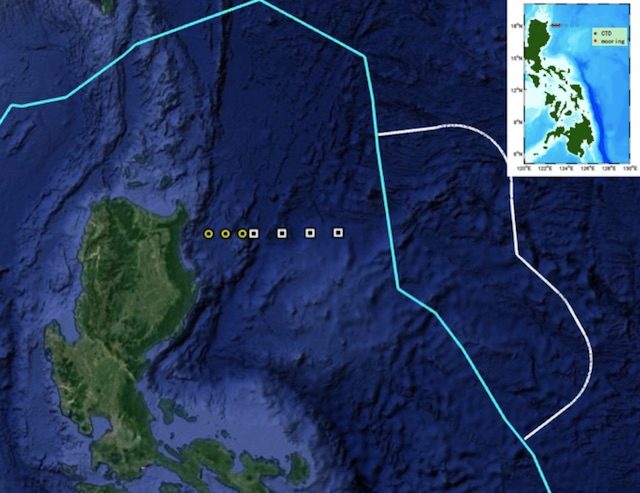SUMMARY
This is AI generated summarization, which may have errors. For context, always refer to the full article.


MANILA, Philippines (UPDATED) – The University of the Philippines Marine Science Institute (UP-MSI) issued a statement on Thursday, January 25, to explain the benefits of its collaboration with a Chinese firm to survey the country’s eastern seaboard, amid controversy involving exploration in the Benham Rise region.
The UP-MSI said the collaboration with China is part of a long-running international collaboration to study the flow of water in the country’s eastern seaboard – its temperature, salinity, and current distribution, and ocean currents, among others – to understand how it affects regional climate and cycles like La Niña and El Niño.
“UP-MSI has been collaborating with oceanographers from different countries such as the US, South Korea, Japan, China and Taiwan on research along the Pacific seaboard as early as the 1980s,” it said in a statement issued Thursday night, January 25.
The collaboration with the Institute of Oceanology of the Chinese Academy of Sciences will study the North Equatorial Current (NEC), which splits as it meets the Philippine coast to form the northward Kuroshio Current and the southward Mindanao Current. (READ: China’s 33-day permit to survey PH’s eastern seaboard begins)
It will focus on the Kuroshio Current, which is “responsible for the transport of heat to the rest of the North Pacific and therefore is an important driver of the regional climate and even the El Niño and La Niña cycles,” the statement said.
“To understand the Kuroshio’s role on climate and to help develop predictive models, we need to know how often and by how much it varies; thus the need to measure the currents and temperature structure over a long period of time,” it added.
Instruments will be deployed for time series measurements along the coast of northern Isabela province, which is located north of Benham Rise. It will measure the volume and heat content of the water flowing to the north.
“In addition, lessons from these oceanographic processes help explain changes in the productivity of the ocean (which is crucial to fisheries management) and contribute to new knowledge (such as changes in monsoon and typhoons), all of which are important in the sustainable development of the northeastern Philippine biogeographic region,” UP-MSI said.
UP-MSI said the Chinese survey vessel Ke Xue Hao will work within the Philippine Exclusive Economic Zone (EEZ) for a maximum of 6 days. The rest of the study will be conducted in the country’s extended continental shelf.
The Chinese firm discussed the collaboration with UP-MSI back in 2016 through an international collaborative observational program called the North Pacific Ocean Circulation Experiment, which the Chinese firm leads.
The project was met with criticisms. Supreme Court Senior Associate Justice Antonio Carpio, who led the country’s international case against China’s “squatting” in the West Philippine Sea (South China Sea), said it was “dumb” to give Beijing access to the other side of the country. He said China should first recognize the United Nations-backed ruling that struck down its 9-dash-line claim over the South China Sea.
China’s intent is being questioned because of its notoriety in the South China Sea, where it reclaimed 7 reefs and turned them into artificial islands that now host runways and missiles.
There was also an uproar when China said that the Philippines did not have “sovereignty” over Benham Rise, an underwater plateau bigger than Luzon that was recently confirmed by the United Nations to be a part of the Philippine’s extended continental shelf. (READ: Fast Facts: What you should know about Benham Rise)
What the Philippines has is “sovereign right” over Benham Rise. Foreign vessels cannot be barred from “innocent passage” but the Philippines has exclusive right to explore and exploit the natural resources in the area. It can also decide to allow other countries to conduct research in the area, as in this case.
But China had been conducting research in Benham Rise in recent years despite the repeated denial of its requests. This is the first known permit granted to China since the 2012 standoff between Manila and Beijing over Scarborough Shoal.
President Rodrigo Duterte has pursued warmer ties with China, setting aside the country’s victory in the Permanent Court of Arbitration in favor of bilateral engagements.
Carpio and other pioneers of the country’s case against China have been vocal critics of the new government policy towards the regional giant.
The Chinese firm discussed the collaboration with UP-MSI back in 2016 through an international collaborative observational program called the North Pacific Ocean Circulation Experiment (NPOCE), which IOCAS leads.
In a public post on Facebook, UP-MSI oceanopgrapher Deo Florence Onda said: “We are not defending anyone but trying to shed light on the matter. Let us go back to the very core of science – collaboration and search for the truth. Again, scientists are not politicians.”
– Rappler.com
Add a comment
How does this make you feel?
There are no comments yet. Add your comment to start the conversation.